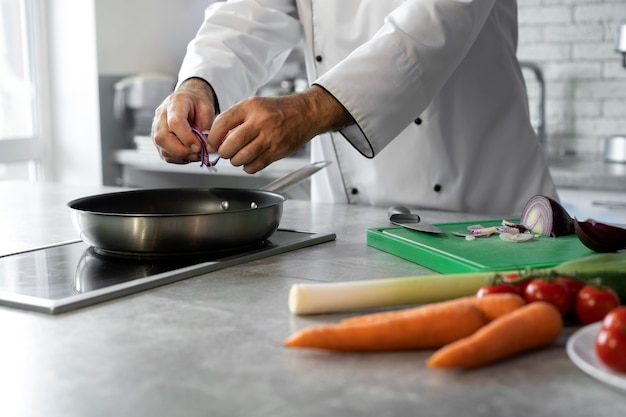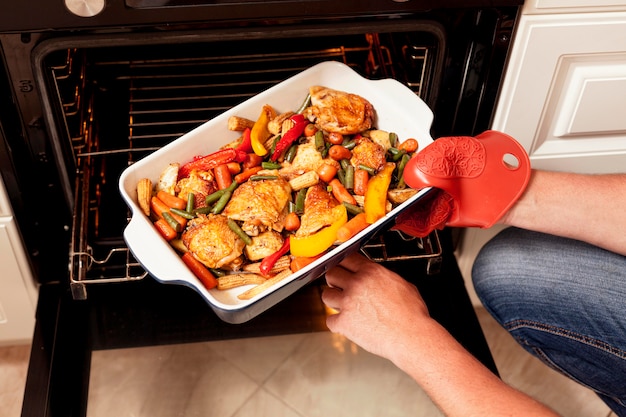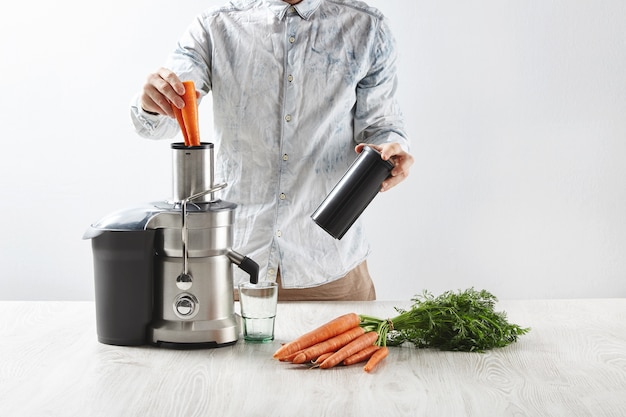Part 1: Picking the Perfect Carrots

We've all been there - standing in the supermarket, facing a mountain of carrots, unsure which ones to grab. You want the best, but how do you know? Don't worry, I've got you covered. Here's the lowdown on choosing the right carrots for stovetop cooking.
Size Matters
Size does matter, but not in the way you might think! For even cooking, you want carrots that are roughly the same size. If you've got a mix of sizes, chop them into equal pieces. I usually aim for carrots that are about the thickness of my thumb - this makes them easy to handle and ensures they cook evenly.
Freshness is Key
A good carrot should feel firm and springy when you touch it. Avoid any that are limp, wrinkled, or have soft spots. The colour is also a key indicator of freshness: vibrant orange carrots are usually the best choice. A pale orange or dull colour can indicate that the carrot is older and might not have as much flavour.
Part 2: Prepping Your Carrots

Washing Up
First things first: give those carrots a good wash. Use cold water and scrub them with your hands or a vegetable brush to get rid of any dirt or grit. Sometimes, the dirt can be stubbornly clinging to the skin. If that's the case, you can try using a gentle vegetable scrub or a damp cloth to help loosen it.
The Great Debate: Peeling or Not Peeling?
This is a topic that sparks endless debates. Some swear by peeling their carrots, while others say the skin is a treasure trove of nutrients and flavour. Honestly, it boils down to personal preference and the type of carrots you're using. For young, tender carrots, you can often skip the peeling. Just give them a good scrub and you're good to go! However, if you're working with older, tougher carrots, peeling might be the way to go. Just make sure to remove any blemishes or stubborn bits of skin.
Slicing and Dicing
Now that your carrots are clean, it's time to get chopping! The way you slice or dice them depends on the recipe.
- For a quick side dish: Slice your carrots into rounds, about 1/4 inch thick. This gives you nice, even pieces that cook quickly and are perfect for simple side dishes.
- For a more substantial dish: Dice your carrots into small, uniform cubes. This creates more surface area and helps them cook evenly. This method is ideal for soups, stews, and dishes where you want the carrots to blend in with other ingredients.
- Want something fancy? Try julienning your carrots – cutting them into long, thin strips. This works great for stir-fries, salads, or adding a decorative touch to your dishes.
Part 3: Cooking Time and Techniques

Boiling Point
Boiling carrots is a classic method, and it's surprisingly simple. Bring a pot of salted water to a rolling boil. The salt is key! It enhances the flavour of the carrots and helps them cook evenly. If you're unsure about how much salt to use, start with a teaspoon per quart of water. You can always adjust it to your taste.
The Perfect Bite
Knowing when your carrots are cooked is crucial. You want them tender, with a slight bite, but not mushy. Here's how to tell if they're done:
- Check for tenderness: Use a fork or a knife to pierce the carrots. If they go through easily, they're ready. If the fork meets resistance, they need a little more time.
- Don't overcook: Carrots can quickly go from tender to mushy if you overcook them. It's always better to err on the side of slightly undercooked. You can always cook them a little longer if needed, but you can't undo overcooked carrots.
Other Cooking Methods
Boiling isn't the only way to cook carrots. Here are some other methods that will bring out different flavours and textures:
- Steaming: This is a great way to retain the nutrients and flavour of the carrots. Simply add your sliced or diced carrots to a steamer basket over boiling water. The steam cooks them gently, resulting in carrots that are tender and bright in colour.
- Sautéing: Heat some oil in a pan over medium heat and add your carrots. Sautéing gives the carrots a lovely caramelized flavour. This method works well with thinly sliced carrots or diced carrots. For added flavour, you can add a pinch of salt, pepper, and herbs towards the end of cooking.
- Roasting: For a richer flavour, roast your carrots in the oven. Toss them with olive oil, salt, and pepper, and roast at 400 degrees Fahrenheit until tender. Roasting concentrates the sweetness of the carrots and creates a slightly crispy exterior. You can also experiment with different herbs and spices to enhance the flavour profile.
Part 4: Seasoning and Serving
Flavor Boosters
You've cooked your carrots, now it's time to make them sing!
- Butter: A classic pairing for carrots, butter adds richness and a creamy texture. It's especially delightful when combined with roasted carrots.
- Fresh Herbs: A sprinkle of chopped parsley, chives, or dill brightens up the flavour. These herbs add a fresh, herbaceous touch, complementing both boiled and roasted carrots.
- Spices: A pinch of cumin, coriander, or paprika adds warmth and depth. For a more complex flavour profile, try a blend of spices like cumin, coriander, and turmeric.
Serving Suggestions
Cooked carrots are a versatile side dish that can be enjoyed with just about anything.
- roast chicken: A classic pairing that never gets old. The sweetness of the carrots complements the savory flavour of roast chicken beautifully.
- Fish: Carrots complement the delicate flavour of fish. They provide a nice contrast in texture and colour, making the dish more visually appealing.
- Salads: Add chopped carrots to your salads for a pop of colour and texture. Carrots add a sweet and crunchy element to salads, making them more interesting and satisfying.
- Soups: Carrots are a key ingredient in many soups and stews. Their sweetness adds depth and complexity to the flavour of the soup.
- Carrot Top Pesto: Don't toss those carrot tops! They're packed with flavour and can be used to make a delicious pesto. Blend them with olive oil, garlic, pine nuts, and Parmesan cheese for a unique and vibrant pesto that's perfect for pasta, sandwiches, or as a spread.
Part 5: carrot recipes
Carrot Side Dish
Ingredients:
- 1 pound carrots, peeled and sliced into rounds
- 2 tablespoons butter
- 1/2 teaspoon salt
- 1/4 teaspoon black pepper
- 1 tablespoon chopped fresh parsley
Instructions:
- Bring a large pot of salted water to a boil.
- Add the carrots and cook for 5-7 minutes, or until tender.
- Drain the carrots and return them to the pot.
- Add the butter, salt, pepper, and parsley. Toss to coat.
- Serve immediately.
Carrot and Ginger Soup
Ingredients:
- 1 tablespoon olive oil
- 1 onion, chopped
- 2 cloves garlic, minced
- 1 inch piece of ginger, grated
- 1 pound carrots, peeled and chopped
- 4 cups vegetable broth
- Salt and pepper to taste
- 1/4 cup heavy cream (optional)
Instructions:
- Heat the olive oil in a large pot over medium heat.
- Add the onion and cook until softened, about 5 minutes.
- Add the garlic and ginger and cook for 1 minute more.
- Add the carrots and broth. Bring to a boil, then reduce heat and simmer for 20 minutes, or until the carrots are tender.
- Use an immersion blender or transfer the soup to a regular blender to blend until smooth.
- Season with salt and pepper to taste.
- Stir in the heavy cream, if using.
- Serve warm.
Part 6: Tips and Tricks
Make It Ahead
Cooking carrots in advance can be a lifesaver, especially if you're short on time. Simply cook them as usual, then store them in the refrigerator for up to 3 days. Just before serving, reheat them in the microwave or on the stovetop. For even better results, reheat them in a pan with a little bit of butter or olive oil to add extra flavour and moisture.
Add Some Colour
Want to add a pop of colour to your plate? Try adding a handful of baby carrots to your next salad or stir-fry. Baby carrots are a great way to add colour, texture, and a little sweetness to your dishes.
Don't Throw Away the Greens
Don't be so quick to toss those carrot tops! They're packed with nutrients and can be used in soups, stews, or even pesto. They add a distinct, earthy flavour that can elevate your dishes.
Part 7: Common Mistakes to Avoid
Overcooking
The biggest mistake you can make is overcooking your carrots. They'll end up mushy and lose their flavour. Keep a close eye on them and use a fork or knife to check for tenderness.
Not Seasoning Enough
Salt and pepper are essential for bringing out the flavour of carrots. Don't be shy! A pinch of salt and a grind of pepper can transform the flavour of your carrots.
Not Trying Different Cooking Methods
There's more to carrots than just boiling them. Don't be afraid to experiment with different cooking methods like steaming, sautéing, or roasting. Each method brings out different flavours and textures.
Part 8: FAQs
Q: How can I tell if a carrot is bad?
A: Look for carrots that are firm and springy to the touch. Avoid any that are limp, wrinkled, or have soft spots. The colour is also a good indicator of freshness – vibrant orange carrots are usually the best choice. If you see any signs of mold or discoloration, it's best to avoid those carrots.
Q: What are the best carrots for roasting?
A: For roasting, you want carrots that are a bit larger and thicker than the ones you'd use for boiling. They should have a firm texture and a deep orange colour. These carrots will hold their shape well during roasting and develop a beautiful caramelized flavour.
Q: Can I freeze carrots?
A: Yes, you can freeze carrots. Just blanch them first by boiling them for 2-3 minutes, then immediately plunge them into ice water. This stops the cooking process and helps preserve their texture and colour. Once they're cool, drain them well, pat them dry, and place them in freezer-safe bags. Frozen carrots are great for soups, stews, and other dishes.
Q: What are some other ways to use carrots?
A: Carrots are incredibly versatile! You can use them in cakes, muffins, breads, and even smoothies. Get creative and experiment with different recipes.
Q: Can I use carrot tops in cooking?
A: Absolutely! Carrot tops are packed with nutrients and can be used in soups, stews, or even pesto. Just make sure to wash them thoroughly before using them. They have a slightly bitter flavour that can add depth to your dishes.
Part 9: The Carrot Journey
Cooking carrots might seem simple, but there's a whole world of flavour and versatility hidden within those humble orange roots. From choosing the perfect carrots to finding the right cooking method, there's always something new to learn. And that's the beauty of it all! Every time I cook carrots, I feel like I'm embarking on a little culinary adventure.
So go ahead, grab a bag of carrots, and get creative. You might just surprise yourself with what you can create. And remember, there's no right or wrong way to cook carrots. Just have fun, experiment, and enjoy the process. Happy cooking!
Everyone is watching

How to Cook Frozen Lobster Tails Perfectly: A Step-by-Step Guide
RecipesLobster. Just the word conjures up images of lavish meals, special occasions, and a taste of luxury. But let's...

Pigs in a Blanket Cooking Time: How Long to Bake for Perfect Results
RecipesAh, pigs in a blanket. Just the name conjures up images of those delightful little parcels of crispy pastry en...

Pork Fillet Cooking Time: How Long to Cook It Perfectly
RecipesPork fillet, or tenderloin as it's sometimes called, is a real favourite in our house. It's so versatile, and...

The Ultimate Guide to Tender, Juicy Pulled Pork
RecipesRight, let's talk pulled pork. It's one of those dishes that just screams "comfort food," doesn't it? I mean...

The Ultimate Guide to Cooking Delicious Frankfurters
RecipesLet's face it, we all love a good frankfurter. It's a classic, simple, and always satisfying. But let's be rea...
